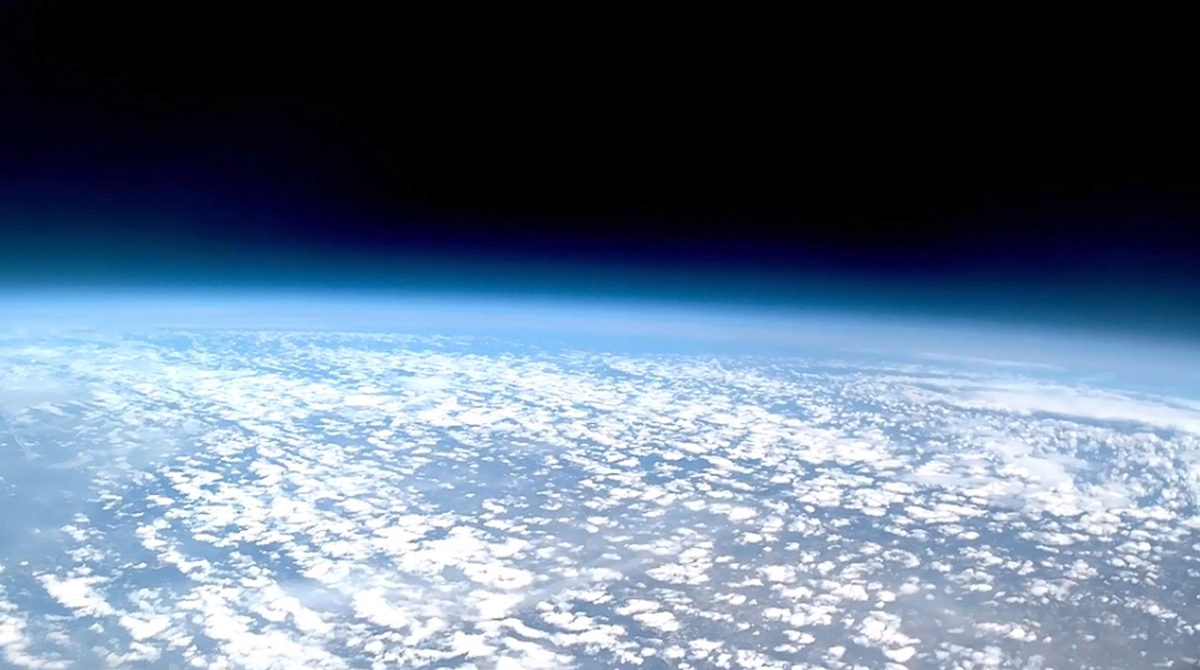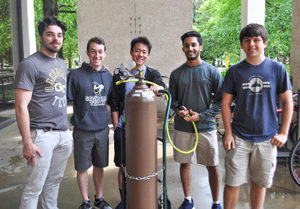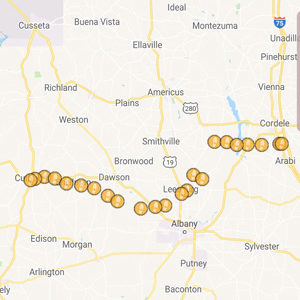
The View from 100,000 feet. That's what Buzzin Ballooners caught in this photo, taken from a Georgia Tech-made balloon that was launched April 20. Watch a video of Buzzin' Ballooners' Launch
Georgia Tech's first-ever entry into the Global Space Balloon Challenge, Buzzin’ Ballooners, climbed to an altitude of 100,000 feet during its April 20 launch, in Cuthbert, Georgia.
 |
| Buzzin Ballooners (l to r) James Fogel, Jarod Vogt, Ryota Tsutsumi, Saajan Patel, and Spencer Ballus |
The seven-member Team Buzzin' Ballooners is now waiting to see whether that height will place it at the top of the world-wide event, which tasked teams to design and launch hand-made balloons between April 5 and April 29. The winners in the "best education initiative" and "best design" categories will receive prizes - higher quality balloon equipment for their next launch. All of the participants got in on the excitement, however.
"The GSBC is the coming together of people around the world to simultaneously fly high altitude balloons from every corner of the globe," the website states. "We are celebrating an age where anyone can reach the edge of space for a few hundred dollars and a few weekends of work."
Sponsored by a consortium of schools and businesses, the Global Space Balloon Challenge is the world’s largest high altitude ballooning event, this year eliciting 593 team entries from 68 countries around the globe. Participants include students, teachers, amateurs, professionals, children and their parents. After launching their balloons, participants are tasked with using their own on-board instrumentation to track their balloons' flights and meet them at their eventual landing spot.
 |
| James Fogel |
“The GSBC is different than a lot of competitions," said AE undergrad, James Fogel, Buzzin’ Ballooners team captain.
"It’s centered on learning high-altitude balloons, but also offers an open-forum of resources and encourages teams to help each other out,”
Helping the Buzzin’ Ballooners to rally were Georgia Tech's Ramblin’ Rocket Club, the Georgia Space Grant Consortium, and AE professor Glenn Lightsey whose avionics research group served as technical consultants.
Though the Global Space Balloon Challenge invites participation from hobbyists, its push to improve the quality of high altitude ballooning (HAB) has a foundation in serious research, says Matt Capuano, president of the Ramblin' Rocket Club.
"Experiments that need to be conducted at high altitudes, such as testing cube-satellite components or biology-related experiments, could find great use in such a service," he said.
After launching a smaller version of the Buzzin’ Balloon to an altitude of 75,000 feet in late March, the team brought a much bigger version to their April 20 launch, where the goal was to reach 100,000 feet.
Like the test launch, the payload in the final launch included a Styrofoam cooler containing GPS sensors to track its location, hand warmers to keep the components from freezing, and a camera to capture footage of the balloon's journey. It also had a 3D-printed fin to stabilize the vehicle during its descent and externally mounted cameras to capture the landing.
Strong winds on the launch day threw off the team's helium measurements, which are extremely important in determining how much lift is needed. Quick thinking by Alex Puckhaber allowed the team to use a low-tech alternative to measure the helium.
 |
| No pings, no hope. The yellow dots on the map, above, indicate the UAV's location when it released each in a series of 'pings.' Where the dots momentarily ceased, Team Buzzin Ballooners didn't know, for certain, if it was still flying. |
"We filled a bucket with 2,000 grams of weight and tied the balloon to the bucket. Once it started to lift the bucket, we knew we had the correct amount of weight needed to carry our payload," explained Fogel.
The team followed their balloon's flight using a GPS tracking app that starts out by emitting a ping every five minutes. Over time, those pings display closer and closer together, until, eventually they are on top of each other -- an indication that the payload has landed, (or at least stopped moving).
That's the way it's supposed to work. On launch day, those pings mysteriously stopped for almost an hour - leaving the balloon's whereabouts completely unknown.
“Things were looking bleak so we decided to go in the direction that we had simulated it landing, with the hope that maybe we’d see it,” said Fogel.
That's when they heard it - faint but recognizable:
*Ping*
“We all flipped out in the car and were excited that we were right about our simulations," said Fogel.
"We started narrowing in on where it landed, which ended up being an abandoned railroad next to an abandoned chicken farm – a horror film in the making."
The team theorizes that, at 80,000 feet, two things happened. First, the balloon succumbed to the continual expansion of gases within, popping, as the team expected it would. Thus, ended its upward journey. Secondly, the GPS froze – literally - causing the battery current to drop significantly. This caused the hour-long GPS black-out. Without its balloon, the payload began its expected descent to the ground. Along the way, the components came back to life as the temperatures rose.
Once it landed, the team sifted through the onboard data and determined that they had, indeed, achieved their goal of 100,000 feet.
This year's team included members from Georgia Tech's Schools of Material Science Engineering and Mechanical Engineering. For their next run, the Buzzin’ Ballooners team hopes to recruit members from additional majors, like electrical and computer engineering and computer science.
“We’re already talking about 3D-printing our own payload for next year and developing our own tracking app so we can be in constant communication with the balloon," said Fogel.
“One of the things I’m most proud of is not necessarily that we got it to work, but the majority of this group is underclassman and the fact that they got really involved with this group early on in their college-career was really cool to see. I wish I would have when I was a first-year student.”
Watch the Buzzin' Ballooners final launch and entry into the 2019 Global Space Balloon Challenge (GSBC)